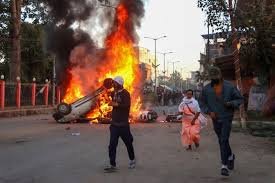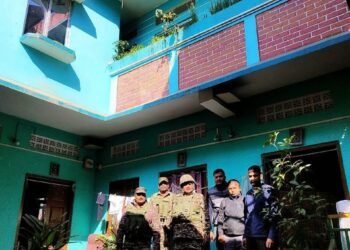Tribal communities, including Kukis, Mizos, and Nagas, unite against border fencing, with the UNC submitting a memorandum to the Governor, emphasizing historical injustices and ongoing tripartite talks.
BY PC Bureau
The contentious Indo-Myanmar border fencing project has triggered widespread protests throughout Northeast India, as tribal communities, including Kukis, Mizos, and Nagas, voice strong opposition. The United Naga Council (UNC) has taken a leading role in these protests, demanding an immediate cessation of the fencing and the reinstatement of the Free Movement Regime (FMR). The UNC argues that the project encroaches upon ancestral Naga lands and disrupts deeply rooted socio-cultural connections.
A UNC delegation met with the Manipur Governor today, submitting a memorandum detailing their grievances. The Council expressed vehement opposition to the international boundary established in the 1950s, which they assert arbitrarily divided Naga tribes between India and Myanmar, without their consent. They contend that the current border fencing project perpetuates this historical injustice by severing centuries-old cultural, social, and economic ties shared by Naga communities on both sides of the border.
ALSO READ: Amid NPP Opposition, First Looted Weapons Surrendered in Manipur
The memorandum further emphasized the ongoing tripartite talks regarding the creation of seven new districts in 2016, overseen by A.K. Mishra, Advisor for Northeast Affairs. The UNC urged Governor A.K. Bhalla to take decisive action to ensure a peaceful resolution, expressing confidence that his leadership could contribute to restoring peace and stability in Manipur, a state grappling with persistent ethnic tensions.
Backgrounder: Contested Borders and Tribal Realities
Northeast India is a region where borders are not merely lines on a map but deeply intertwined with the lives and identities of its diverse tribal populations. The Indo-Myanmar border, in particular, has long been a porous boundary, facilitating trade, cultural exchange, and familial connections between communities on both sides. The FMR, which allowed for free movement up to 16 kilometers across the border, was a recognition of these ground realities.
ALSO READ: Identity Clash: “Young Kuki” Unleashes Torrent of Evidence
However, the Indian government’s decision to fence the border and suspend the FMR, citing concerns about drug trafficking and illegal immigration, has been met with strong resistance from tribal groups. They argue that these measures disregard the historical and cultural realities of the region and will have severe socio-economic and environmental consequences.
UNC’s Demands and Concerns
The UNC’s memorandum to Governor Bhalla outlines several key demands and concerns:
- Halt to Border Fencing: The Council argues that the fencing project cuts through ancestral Naga lands and disrupts centuries-old cultural, social, and economic ties.
- Restoration of FMR: The UNC calls for the restoration of the FMR, arguing that its removal has severely impacted Naga communities with ancestral lands on both sides of the border. They also suggest expanding the FMR from 16 km to 40 km, as it was in the 1950s.
- Tripartite Talks: The Council urges the Governor’s intervention in the ongoing tripartite talks between the Government of Manipur, the Government of India, and the UNC regarding the rollback of newly created districts in 2016.
- Historical Boundaries: The UNC asserts that any border demarcation must be based on historical and traditional boundaries to prevent further unrest.
- Socio-Economic and Environmental Impacts: The Council highlights concerns about the negative impact of border fencing on wildlife, migratory routes, and biodiversity. They also point to the socio-economic consequences for border communities.
- Rejection of Government Justification: The UNC dismisses the government’s claim that fencing and ending FMR will control drug trafficking and illegal immigration, arguing that there is no evidence of such issues in Naga areas. They suggest alternative measures, such as the National Register of Citizens (NRC).
- Indo-Naga Political Issue: The Council urges the Government of India to engage in sincere dialogue to resolve the Indo-Naga political issue, referring to the Framework Agreement as a basis for achieving lasting peace.
Widespread Tribal Protests
The UNC’s demands have resonated with tribal groups across Northeast India, leading to widespread protests.
- Manipur: Kuki organizations have joined Naga groups in staging rallies and demonstrations, demanding a halt to the fencing and the restoration of the FMR.
- Mizoram: Mizo groups have expressed solidarity with the Naga and Kuki people, highlighting the shared historical and cultural ties between these communities. They are concerned that the border fencing and FMR suspension could have wider implications for tribal rights and historical recognition.
- Nagaland: Tribal bodies have issued statements condemning the border fencing, emphasizing the importance of respecting historical facts and promoting inter-community harmony.
Protestors are carrying placards and chanting slogans, demanding that the government address their concerns and respect their historical and traditional rights. Tribal leaders are calling for a dialogue-based approach to resolving the border issue, emphasizing the need for the government to understand the ground realities of the region.













